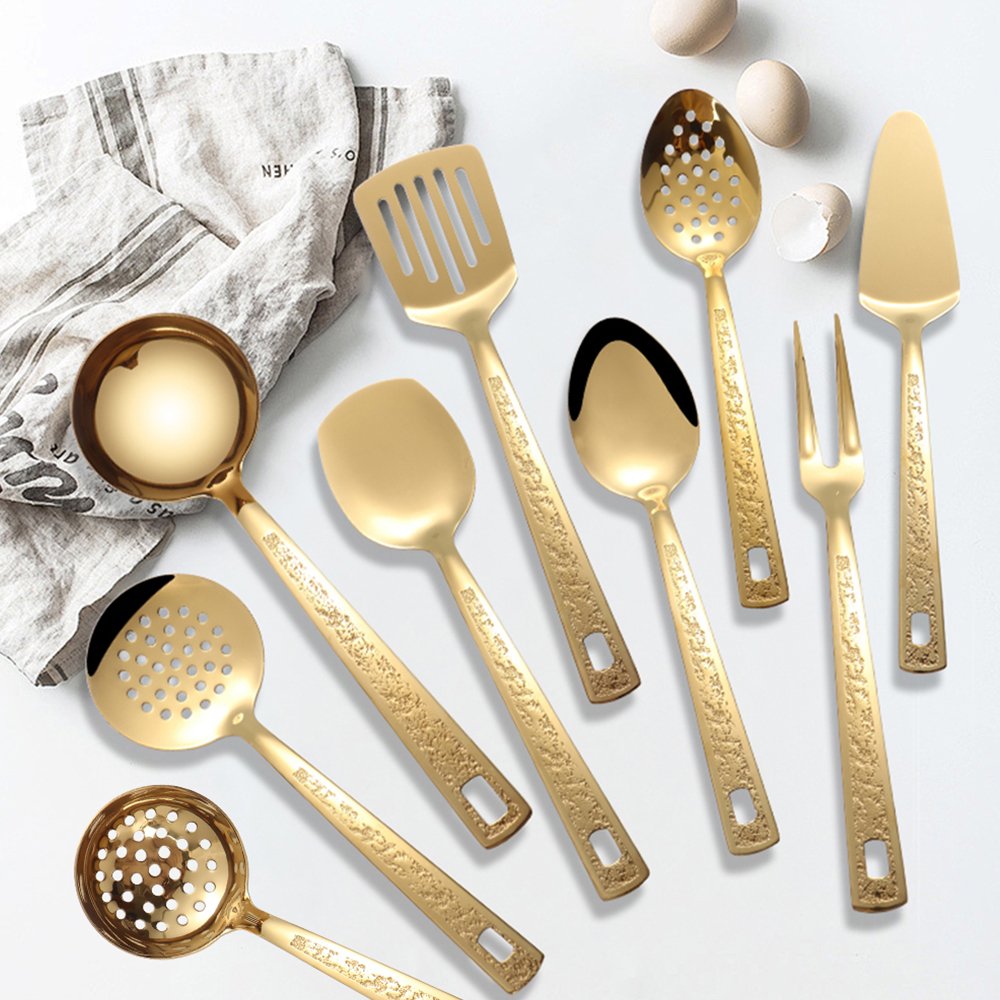In today’s kitchens, the choice of materials for utensils plays a vital role in ensuring safety, performance, and longevity. Selecting the right material for your kitchen tools can make cooking easier, safer, and more efficient. But with so many options available, it can be overwhelming to know which materials are best suited for your cooking needs. This article will explore the different types of materials commonly used in kitchen utensils, their pros and cons, and help you make the best choices for your kitchen.
Choosing the right material for kitchen utensils is essential for safety and durability. Stainless steel, wood, and silicone are great options, while low-quality plastics and aluminum should be avoided for safety reasons.
Let’s take a closer look at the most common materials used in kitchen utensils and how they compare to each other.
Table of Contents

Which Material is Used to Make Kitchen Utensils?
Kitchen utensils are made from a variety of materials, each offering different benefits and drawbacks. Some of the most popular materials include stainless steel, plastic, silicone, wood, and bamboo.
Each material used in kitchen utensils has its specific benefits. Stainless steel is known for durability and resistance to rust, while silicone is heat-resistant and safe for non-stick cookware. Wood offers a natural, non-reactive surface.
Stainless Steel: Durable and Reliable
Stainless steel is one of the most commonly used materials in kitchen utensils. It is resistant to rust, durable, and does not react with food. It’s an ideal choice for utensils that need to withstand heat and heavy use, such as spoons, spatulas, and tongs.
Silicone: Safe for Non-Stick Cookware
Silicone is another material commonly used in cooking tools. It is heat-resistant and flexible, which makes it perfect for non-stick pans. Silicone utensils are gentle on cookware, preventing scratches and damage while being safe for high temperatures.
Wood: A Traditional Favorite
Wood is often used for utensils like spoons and spatulas. It is gentle on cookware, especially non-stick surfaces, and does not conduct heat, reducing the risk of burns. However, wood can wear down over time and may need to be replaced.
What is the Safest Material for Kitchen Utensils?
The safest materials for kitchen utensils are those that don’t leach harmful chemicals into food, are heat-resistant, and won’t cause damage to cookware.
The safest materials include stainless steel, silicone, and wood. These materials are non-reactive, durable, and provide a safe cooking experience without the risk of contamination.
Non-Reactive Materials
Stainless steel, silicone, and wood are non-reactive materials. Unlike aluminum or certain plastics, they do not interact with food, which helps preserve the taste and safety of your meals. Stainless steel is particularly renowned for its ability to withstand high temperatures without altering the food’s flavor or safety.
Avoiding Harmful Chemicals
Certain low-quality plastics and non-stick coatings can leach harmful chemicals like BPA or PFOA when exposed to heat. These materials should be avoided in the kitchen to ensure the safety of both the food being prepared and the person preparing it.
What Are Kitchen Utensils Made Of?
Kitchen utensils come in a wide variety of materials that cater to different types of cooking needs. Some materials are better for heat resistance, while others are more suitable for durability or non-stick purposes.
Common materials for kitchen utensils include stainless steel, wood, silicone, and plastic. Stainless steel is ideal for durability, silicone for flexibility, and wood for gentle handling of cookware.
Stainless Steel
Stainless steel is one of the most versatile and commonly used materials in kitchen utensils. It resists rust, corrosion, and staining, making it perfect for high-use items like knives, forks, and spoons. It is also heat-resistant, so you can use stainless steel utensils for cooking at high temperatures without concern.
Silicone and Wood
Silicone is an excellent option for cooking tools that require flexibility and heat resistance. Wood, on the other hand, is used for utensils like spoons and spatulas as it is non-reactive and safe for non-stick cookware. Bamboo is another natural option known for being both eco-friendly and durable.
What Are the 5 Main Categories of Kitchen Utensils?
Kitchen utensils can be broadly categorized based on their function, which helps when deciding what material to choose for each type of tool.
The five main categories of kitchen utensils are cutting tools, stirring tools, flipping tools, serving tools, and measuring tools. Each category may require different materials for optimal performance.
Cutting Tools
Cutting tools like knives and scissors are primarily made of stainless steel due to its sharpness, strength, and rust resistance. Stainless steel ensures a long-lasting edge and durability making it ideal for cutting tasks in the kitchen.
Stirring Tools
Stirring tools such as spatulas and spoons are often made from wood, silicone or stainless steel. Wood is excellent for stirring soups and sauces as it is gentle on cookware while silicone is ideal for non-stick pans. Stainless steel offers durability and strength for heavy stirring.
Flipping Tools
Flipping tools like spatulas and turners are usually made from stainless steel or silicone. Stainless steel is sturdy and can handle high heat while silicone is great for preventing scratches on non-stick surfaces.
Serving Tools
Serving tools like ladles, serving spoons, and tongs are made from various materials, including stainless steel, wood, and silicone. Stainless steel provides strength and reliability, while wood and silicone are gentle on cookware.
Measuring Tools
Measuring cups and spoons are typically made of stainless steel or plastic. Stainless steel is more durable, while plastic is lightweight and easier to store.
Which of the Following Material Is Most Suitable for Making Cooking Utensils?
The suitability of materials for cooking utensils depends on factors like heat resistance, durability, and safety.
The most suitable materials for cooking utensils are stainless steel, silicone, and wood. These materials are heat-resistant, durable, and non-reactive with food.
Stainless Steel for Durability
Stainless steel is ideal for utensils that need to withstand heavy use, such as spatulas and tongs. It is durable, rust-resistant, and doesn’t react with food, making it a top choice for cooking utensils.
Silicone for Heat Resistance
Silicone is heat-resistant and flexible, making it perfect for non-stick cookware. It prevents scratching and ensures a longer lifespan for your kitchen tools.

What Are Regular Utensils Made Of?
Regular kitchen utensils, such as spoons, forks, and knives, are commonly made from stainless steel, although some may also be made from plastic or wood.
Regular utensils are often made from stainless steel for strength and durability. Other materials like plastic and wood may be used for utensils designed for specific tasks or aesthetics.
Stainless Steel’s Dominance
Stainless steel is the material of choice for most regular kitchen utensils due to its strength, resistance to rust, and ease of cleaning. It is durable and maintains its appearance over time.
What Is the Least Toxic Cooking Material?
The least toxic materials for cooking utensils are those that do not leach harmful substances into food when exposed to heat.
Materials like stainless steel, wood, and silicone are considered non-toxic. These materials are safe to use in cooking without the risk of chemicals contaminating food.
Safe Cooking Materials
Stainless steel, wood, and silicone are the least toxic cooking materials. They do not release harmful chemicals into food, ensuring a safer cooking experience. Avoid materials such as aluminum or plastic with BPA, which can leach toxins when heated.
Which Metal Is Not Good for Cooking Utensils?
Certain metals should be avoided when selecting utensils due to their reactivity with food or potential to release harmful substances.
Aluminum is often considered a poor choice for cooking utensils because it can react with acidic foods and alter the taste, as well as potentially release harmful substances when exposed to high heat.
Aluminum’s Reactivity
Aluminum is a lightweight metal, but it is highly reactive with certain foods, especially acidic ingredients. This reactivity can cause a metallic taste and may pose a health risk if the aluminum is exposed to high temperatures or used for long periods. It’s best to choose stainless steel or silicone over aluminum for cooking.
Which Material Is Not Recommended for Kitchen?
Some materials should be avoided when selecting kitchen utensils due to safety concerns or performance limitations.
Materials like low-quality plastics and non-stick coated items with chemicals such as PFOA should be avoided. These can release harmful substances when heated and may compromise the safety of your food.
Avoid Low-Quality Plastics
Plastics made with BPA and other chemicals can leach harmful substances into food when exposed to heat. These materials should be avoided in the kitchen, especially when cooking with high temperatures. Always opt for non-toxic materials like stainless steel, silicone, or wood.
Choosing the right material for your kitchen utensils is crucial for both safety and performance. By understanding the advantages and limitations of different materials like stainless steel, wood, and silicone, you can ensure a safer, more efficient cooking experience. Remember to avoid low-quality plastics and aluminum to protect both your health and your cookware.
Selecting the right material for your kitchen utensils is essential for safety, durability, and performance. Opt for stainless steel, wood, or silicone for the best results in your kitchen.



